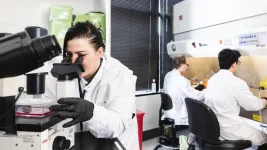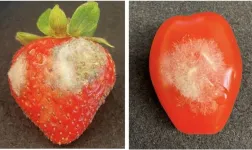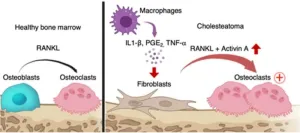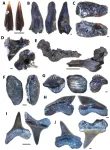(Press-News.org) COLUMBUS, Ohio – A first-of-its-kind study examined 2.2 million news stories shared on Facebook and found that publishers create two very different news environments.
These distinct ecosystems involve low-credibility publishers – those that publish what is sometimes referred to as fake news – versus high-credibility publishers.
Findings showed that while these two types of publishers often pushed out bursts of coverage at the same time – a common feature of news coverage – they were often about different topics, said Kelly Garrett, senior author of the study and professor of communication at The Ohio State University.
“These aren’t just random differences in what is being covered – there seems to be some systematic bias happening here,” Garrett said.
“Low- and high-credibility publishers often give their readers distinct versions of what are the most important topics at a particular time.”
The results may have troubling implications for news consumers and for those trying to fight the spread of misinformation on social media, Garrett said.
The study was published this week in the journal New Media & Society.
This research comes from a team that has access to a unique collection of anonymous data from Facebook on the sharing of online news content. Their goal was to examine the supply of low-credibility information, which may pose harmful influences on what people learn about science, politics and their community.
The researchers examined more than 2 million online news stories that were shared at least 100 times by Facebook users from February 2017 to April 2019.
A publisher was marked as low-credibility if it was included in one of six lists of low-credibility news domains created by reputable fact checkers and scholars, or if it produced more than five articles labeled as problematic by Facebook fact checkers. Some examples include Breitbart News Network and Daily Kos.
High-credibility sites were identified by two academic sources of traditional news sites. Examples included the New York Times and the Wall Street Journal.
The researchers examined news stories shared on Facebook to identify bursts of coverage that occurred when many outlets ran stories on the same topic at the same time. For example, the study found multiple bursts of coverage concerning the family of Barack Obama, the Trump organization, Medicaid, NASA and the Emmy Awards, among many others.
Findings showed that low-credibility publishers more often converged on stories about politics and the government than did high-credibility publishers, whose topics ranged more widely.
Researchers found that after periods of relative quiet in terms of the number of stories run, publishers put out bursts of coverage during certain periods. It was notable that both high- and low-credibility publishers tended to put out bursts of coverage at the same time – but they often were about different topics.
When high-credibility publishers put out a burst of coverage on a particular topic – say Trump or NASA – only 40% of the time did low-credibility publishers have a burst of coverage on the same topic at the same time.
“That’s not trivial, but it is lower than what we would expect if credibility played no role in what these outlets covered,” Garrett said.
The study can’t tell why the two types of publishers put out bursts of coverage on different issues at the same time, Garrett said. But it is consistent with the belief that some partisan news outlets try to counteract negative news about their ideological side by focusing their news coverage on another topic.
However, Garrett noted that ideology is not the biggest divide between the two types of publishers in this study.
While the researchers found, as expected, differences in coverage based on political ideology, the biggest difference in what publishers covered was based on their credibility, not on their partisan stance.
“We would expect conservative- and liberal-leaning publications to behave like other outlets that share their ideology, and they do. But we see the credibility divide is even bigger than the ideological divide in determining what topics they cover,” Garrett said.
“In other words, publishers’ preferences for covering topics covered by outlets of similar credibility is much stronger than their preference for covering topics of outlets sharing similar ideology.”
Garrett noted that low-credibility publishers were originally distinguished from high-quality publishers by how they report the news. But these results suggest the difference runs deeper to include what they cover and when they cover it.
High-credibility publishers have long been seen as following “pack journalism” in which news outlets look to see what stories other similar outlets are covering to determine their story selection.
Although this study can’t say for sure, the same may be happening among low-credibility publishers – although their definition of the most important stories of the day is often distinct from their high-credibility peers, Garrett said.
“Low-credibility publishers may have a different set of news values than the high-credibility publishers,” he said.
These results suggest it may be more difficult than often thought to counter “fake news” put out by low-credibility publishers, according to Garrett.
Fact checkers often work at the story level, trying to correct misinformation put out in one article by one publisher. But this study suggests bursts of coverage in low-credibility publications may be putting out misleading information on the same topic in a variety of forms and in a variety of news outlets.
“We tell people that they should get their news from a variety of sources to reduce the risk of being misled. But that doesn’t work as well if many low-credibility outlets are talking about the same stuff,” Garrett said.
“There’s a little more nuance to what it takes to be a well-informed person. You can’t just be reading multiple news stories. You have to be reading sources that are well known to be credible.”
The lead author of the study was Ceren Budak, associate professor of information at the University of Michigan. Other co-authors were Drew Margolin from Cornell University, Lia Bozarth of the University of Michigan, Jason Jones of Stony Brook University and Robert Bond of Ohio State.
END
Sharing on Facebook reveals 2 very different news environments
Study finds credibility of publishers affects topics covered
2023-08-03
ELSE PRESS RELEASES FROM THIS DATE:
The Access to Advanced Health Institute receives $18 million award to develop a temperature stable, single-dose chikungunya RNA vaccine through a phase 1 clinical trial
2023-08-03
The Access to Advanced Health Institute Receives $18 Million Award to Develop a Temperature Stable, Single-Dose Chikungunya RNA Vaccine Through a Phase 1 Clinical Trial
KEY POINTS:
The goal of the award is to develop an effective chikungunya vaccine candidate that can reach endemic areas of the world by using AAHI’s innovative RNA platform technology.
The project will demonstrate that classic large-scale manufacturing challenges of live-attenuated vaccines can be overcome by using standard manufacturing equipment and techniques that are easy to tech transfer and scale.
The award supports a first-in-human clinical trial of a dried (lyophilized) ...
A path to defeating crop-killing gray mold without toxic chemicals
2023-08-03
It’s a mold that causes billions in crop losses every year, infecting berries, tomatoes and most other fruits and vegetables. Now, researchers have found a way to defeat the mold without showering toxic chemicals on the crops.
If you’ve ever seen a fuzzy gray strawberry, you’ve seen gray mold. It affects more than 1,400 different plant species, and there is no real cure for it. Being able to control it may hinge on the discovery of lipid “bubbles” secreted by the ...
Disparities in Black adults’ stroke risk factors persist; risk factor control reduced gap
2023-08-03
Research Highlights:
In a retrospective analysis of stroke patients, Black adults who had a stroke due to a severe blockage of a major artery in the brain (intracranial atherosclerotic stenosis) were younger, had higher rates of high blood pressure and Type 2 diabetes, and had lower physical activity scores compared to non-Black adults.
After one year of aggressive, individualized medical management, including lifestyle coaching and regular follow-up care, diastolic blood pressure and physical activity scores improved among Black adults.
Embargoed until 4 a.m. CT/5 a.m. ET, Thursday, Aug. 3, 2023
DALLAS, Aug. 3, 2023 — Significant stroke risk factor disparities ...
Ear today, gone tomorrow? A new discovery in a cause of inner-ear bone loss
2023-08-03
Osaka, Japan – Chronic inflammation of the middle ear can cause several problems and complications that can affect a person’s hearing and balance. One such problem is the formation of a cholesteatoma, which is an abnormal collection of cells in the ear that can cause bone erosion if left untreated. In turn, this can cause symptoms such as hearing loss, dizziness, facial paralysis, and even a brain infection.
In a study published recently in Nature Communications, researchers from Osaka University have revealed the cause of cholesteatomas, which may help in developing new therapies for patients who are suffering ...
TENS machine provides cheaper and non-invasive treatment for sleep apnoea
2023-08-03
A machine commonly used for pain relief has shown to improve breathing in patients with obstructive sleep apnoea, a clinical trial has found.
Results of the TESLA trial, published today in eClinical Medicine by researchers from King’s College London and Guy’s & St Thomas’ NHS Foundation Trust, shows the potential of a new therapeutic option for patients using a transcutaneous electrical stimulation (TENS) machine.
Sleep apnoea affects about 1 billion people worldwide, and millions in the UK. The condition can be frequently associated with snoring; ...
Better coaching to promote a person’s growth
2023-08-03
CLEVELAND—What if there was a more effective way to coach and inspire your employees? Athletes? Students? Even your kids?
A new study by a team of researchers from Case Western Reserve University suggests there is.
Their newly published work used neuroimaging to peer into the brains of participants as they responded to two different styles of coaching. The researchers wanted to see what happens in the brain that either helps people grow or causes them to resist change.
“You could say it’s about how we get around the problem that you can lead a horse to water, but you can't make it drink,” said Anthony “Tony” ...
Canadian paleontologists discover microvertebrate faunal assemblages in Manitoba, Canada
2023-08-03
Canadian vertebrate palaeontologist, Aaron Kilmury, and a team of researchers from the University of Manitoba have published new research in PeerJ Life and Environment, unveiling the first-ever formal description of microvertebrate fossil assemblages from the late Cenomanian to middle Turonian periods in Manitoba, Canada.
“One of the most significant findings of this study is that the new microvertebrate material described from Manitoba shares several similarities with microvertebrate assemblages collected ...
Robots cause company profits to fall – at least at first
2023-08-03
Researchers have found that robots can have a ‘U-shaped’ effect on profits: causing profit margins to fall at first, before eventually rising again.
The researchers, from the University of Cambridge, studied industry data from the UK and 24 other European countries between 1995 and 2017, and found that at low levels of adoption, robots have a negative effect on profit margins. But at higher levels of adoption, robots can help increase profits.
According to the researchers, this U-shaped phenomenon is due to the relationship between reducing costs, developing new processes ...
Researchers are using monkey poop to learn how an endangered species chooses its mates
2023-08-03
Northern muriquis, which live in the Atlantic forest of Brazil, are one of the most endangered species of monkey in the world. Choosing good mates and rearing thriving offspring are key to the species’ long-term survival.
To better understand what goes on in the mating lives of muriquis, researchers at the University of Texas at Austin and the University of Wisconsin–Madison turned to the monkeys’ poop to help gain insight into how the primates choose their mates.
In a paper published on Aug. 2 in the journal Proceedings of the Royal Society B, the scientists combined genetic analysis with long-term behavioral observations to better understand the ...
Study shows care hotel model can successfully shorten hospital stays and reduce costs for non-emergency procedures
2023-08-03
CONTACT: Camille Jewell
cjewell@vancomm.com or 202-248-5460
SAN DIEGO—Using a “care hotel” model, which discharges patients to a specialty hospital hotel after smaller surgeries, can lower costs and shorten patients’ time in the hospital, according to a study presented today at the Society of NeuroInterventional Surgery’s (SNIS) 20th Annual Meeting.
Rising health care costs pose a significant financial burden across the U.S., especially since the start of the COVID-19 pandemic. Researchers at the Mayo Clinic Florida ...
LAST 30 PRESS RELEASES:
Young adults commonly mix cannabis with nicotine and tobacco
Comprehensive review illuminates tau protein's dual nature in brain health, disease, and emerging psychiatric connections
Book prepares K-12 leaders for the next public health crisis
Storms in the Southern Ocean mitigates global warming
Seals on the move: Research reveals key data for offshore development and international ecology
Sports injuries sustained during your period might be more severe
World's first successful 2 Tbit/s free-space optical communication using small optical terminals mountable on satellites and HAPS
Can intimate relationships affect your heart? New study says ‘yes’
Scalable and healable gradient textiles for multi‑scenario radiative cooling via bicomponent blow spinning
Research shows informed traders never let a good climate crisis go to waste
Intelligent XGBoost framework enhances asphalt pavement skid resistance assessment
Dual-function biomaterials for postoperative osteosarcoma: Tumor suppression and bone regeneration
New framework reveals where transport emissions concentrate in Singapore
NTP-enhanced lattice oxygen activation in Ce-Co catalysts for low-temperature soot combustion
Synergistic interface engineering in Cu-Zn-Ce catalysts for efficient CO2 hydrogenation to methanol
COVID-19 leaves a lasting mark on the human brain
Scientists use ultrasound to soften and treat cancer tumors without damaging healthy tissue
Community swimming program for Black youth boosts skills, sense of belonging, study finds
Specific depressive symptoms in midlife linked to increased dementia risk
An ‘illuminating’ design sheds light on cholesterol
Who is more likely to get long COVID?
Study showcases resilience and rapid growth of “living rocks”
Naval Research Lab diver earns Office of Naval Research 2025 Sailor of the Year
New Mayo-led study establishes practical definition for rapidly progressive dementia
Fossil fuel industry’s “climate false solutions” reinforce its power and aggravate environmental injustice
Researchers reveal bias in a widely used measure of algorithm performance
Alcohol causes cancer. A study from IOCB Prague confirms damage to DNA and shows how cells defend against it
Hidden viruses in wastewater treatment may shape public health risks, study finds
Unlock the power of nature: how biomass can transform climate mitigation
Biochar reshapes hidden soil microbes that capture carbon dioxide in farmland
[Press-News.org] Sharing on Facebook reveals 2 very different news environmentsStudy finds credibility of publishers affects topics covered





